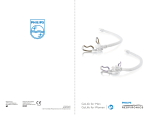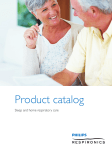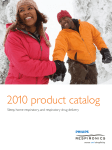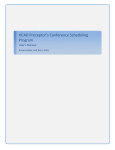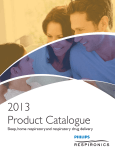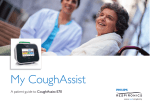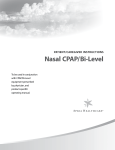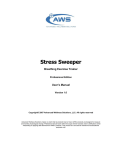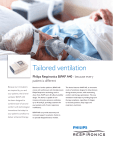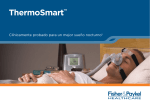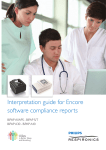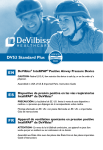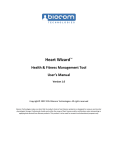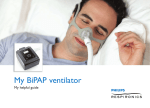Download Therapy guide
Transcript
Therapy guide A simple guide to managing your treatment of Obstructive Sleep Apnea OSA therapy guide: manage your treatment effectively a You have been diagnosed with Obstructive Sleep Apnea (OSA) b What is Obstructive Sleep Apnea? c Therapy and the benefits of regular treatment d Understanding your equipment e How to use and care for your device a You have been diagnosed with OSA You have been experiencing difficulty sleeping. You may snore loudly, or you are gasping or choking at night. b What is Obstructive Sleep Apnea? If you have OSA (Obstructive Sleep Apnea), you stop breathing repeatedly during sleep because your airway collapses. Upper airway collapse may be due to decreased muscle activity, increased tissue around the airway, or structural features that lead to a narrowed airway. As a result, air is prevented from getting into the lungs, carbon dioxide levels in the blood rise, and sleep is disrupted. Opened upper airway Closed upper airway Clear and open upper airway Snoring and apneas (breathing allows air to flow freely to and pauses) are observed when the from the lungs. upper airway collapses. Some simple measures can help in treating OSA, such as: •Weight loss •Avoiding alcohol in the evening •Sleeping on your side However, these measures may not completely resolve OSA. c Therapy and the benefits of regular treatment PAP (positive airway pressure) is an effective treatment for Obstructive Sleep Apnea. PAP therapy is non-invasive and reduces upper airway collapse during sleep by providing a gentle flow of air through the upper airway, allowing you to breathe freely. A PAP therapy system has 3 component parts: The device Small enough to fit on your bedside table. The mask A nasal mask fits over just the nose, and a full face mask fits over the nose and mouth. The supply tubing Connects the device and mask. It is important to use your PAP device as prescribed by your sleep specialist while you sleep. Symptoms can reappear if you are an irregular user. Untreated OSA also has been shown to co-exist with a number of other medical conditions, such as: •High blood pressure •Type 2 diabetes •Cardiovascular disease •Irregular heart rhythm •Stroke Using your PAP device regularly as prescribed by your sleep specialist each night can minimize the impact of OSA in your life. As a result, you may experience the following benefits of treatment:1,2,3,4 •Lower blood pressure •Improved mood •Less sleepiness during the day time •Improved memory, attention and concentration •Fewer awakenings during the night to go to the bathroom •Improved overall quality of life •Decreased risk of sleepiness related motor vehicle accidents •Decreased risk for cardiovascular disease 1. Logan, AG, et al. “Refractory hypertension and sleep apnoea: Effect of CPAP on blood pressure and baroreflex,” Eur Respir J 2003; 21: pp 241–247. 2. Martínez-García, MA, et al. “Effect of CPAP on blood pressure in patients with obstructive sleep apnea and resistant hypertension, The HIPARCO Randomized Clinical Trial,” JAMA December 11, 2013; Vol. 310 (22): pp 2407-2415. 3. Babu, AR, et al. “Type 2 diabetes, glycemic control, and continuous positive airway pressure in obstructive sleep apnea,” Arch Intern Med Feb 28, 2005; Vol. 165: pp 447-452 4. Young, LR, et al. “Response to CPAP withdrawal in patients with mild versus severe obstructive sleep apnea/hypopnea syndrome,” Sleep 2013; Vol. 36 (3): pp 405-412D. d Understanding your equipment Before you begin treatment, it is recommended that you become familiar with your therapy device and mask. User instructions are provided with your equipment. It is very important that you take enough time to read the information provided. CPAP therapy devices A continuous Positive Airway Pressure (CPAP) device is the most commonly used treatment for OSA. CPAP provides a continuous stream of air to keep your upper airway open. System One devices are equipped with unique comfort features to enable you to use your therapy successfully. C-Flex: Technology that helps to reduce the amount of pressure when you exhale, making your exhalation more comfortable in comparison to a standard PAP device. A-Flex: Unique technology available in some CPAP devices that softens the pressure transition from inhalation to exhalation to improve comfort. A-Flex technology makes breathing more natural compared to a standard PAP (Positive Airway Pressure) therapy device. Bi-level therapy devices While CPAP devices are aimed at delivering a constant pressure, Bi-level therapy devices are set to deliver two levels of pressure during the night – a lower pressure when you exhale and a higher level of pressure when you inhale. These devices can be prescribed for patients who have trouble tolerating CPAP therapy. Bi-Flex: Comfort Technology makes both inhalation and exhalation more comfortable compared to a standard bilevel therapy device. Humidifier The humidifier is designed to add moisture to the air that is being delivered to you from the therapy device. By doing this, the humidifier may help to reduce some of the side effects of therapy, such as nasal irritation and upper airway dryness, and increase comfort. 5,6 Additionally, during cold evenings, the humidity control feature of the System One device may help to reduce the formation of water droplets in your tube and mask. For people who sleep in a particularly cold environment, the new, optional, heated tube provides greater levels of absolute humidity. System One devices come with a unique humidifier that is designed to prevent water from getting into the device and causing damage. Tubing The tubing is used to carry the air from the therapy device to the mask. System One features a 15 mm tubing option, which offers flexibility for ease in packing, and it is lightweight. 5. Rakotonanahary, D, et al. “Predictive factors for the need for additional humidification during nasal continuous positive airway pressure therapy,” Chest 2001; 119: pp 460-465. 6. Koutsourelakis, I, et al. “Nasal inflammation in sleep apnoea patients using CPAP and effect of heated humidification, A randomized, sham-controlled, crossover study,” ERJ Express July 1, 2010; doi: 10.1183/09031936.00036910. d Understanding your equipment (continued) Masks A comfortable, well fitted mask is a key factor in being able to use your treatment daily. Talk to your sleep specialist about the different masks that are available. Once you have found a mask that works for you, it is important to maintain it according to the instructions for use that accompany the mask. Inspect your mask often for wear and tear, and when you think it is ready for replacement, contact your sleep specialist. Nasal masks include: Wisp EasyLife ComfortGel Blue TrueBlue Minimal contact masks include: OptiLife GoLife Full face masks include: ComfortGel Blue Full FitLife Amara Some of these illustrated masks may not be available in some markets. Steps in choosing the correct mask: A Select the most appropriate mask according to whether or not you can breathe through your nose. A full face mask is required if you are a mouth breather. B Spend time selecting the correct size mask using an appropriate sizing gauge.* C Once fitted with a mask, it is important that you do not overtighten the headgear.* D It is important that you familiarize yourself with the fine adjustments of the mask to achieve a comfortable fit.* *Please refer to the user manual of your mask for details. Tips for a better seal Air leaks around your eyes, and there is pressure on your lip. 1 2 How to adjust 1. Click and slide the adjuster upwards. 2. Loosen the bottom strap of headgear. Air escapes at the bottom of the mask, and there is excessive pressure on your nose and forehead. 2 1 How to adjust 1. Click and slide the adjuster downward. 2. Loosen the top strap of headgear. For individual mask fitting steps, please refer to the user manual of your mask. e How to use and care for your device Tips on how to set up your device for treatment A Place the machine on a hard level surface close to where you sleep. B Connect power source into power outlet on back of device. Plug power cord into power source and wall outlet. C Check air inlet filter to make sure it is in place and free of dust. D Connect one end of the tubing (hose) to the airflow outlet on the machine and the other end to the mask (or valve). E Put on your mask. Turn control wheel until screen display reads (Therapy). Then press to start blower. The screen will automatically change to pressure setting. F Activate the ramp if needed. B power supply line C air inlet filter E control wheel D tubing (hose) F (back of unit) (back of unit) How to use and care for your humidifier • Empty the humidifier every morning and let it air dry. • Fill the humidifier with fresh, distilled water every evening. • Always use distilled water in the humidifier to avoid mineral deposit build-up. • Clean the humidifier chamber frequently to prevent mold growth. We recommend using distilled water to clean the humidifier of deposits, or buying a new chamber when it’s full of scale. Be sure to thoroughly rinse with distilled or sterile water prior to the use of the humidifier. Follow these simple guidelines prior to moving or transporting your device. Warning •To avoid electrical shock, always unplug the power cord from the wall outlet or DC power source before cleaning or transporting the humidifier. Caution •When moving or transporting your device while it is connected to the humidifier, make sure the water tank is removed first and emptied. a Switch off power supply. b Remove humidifier’s water tank from unit. Empty the water tank. Make sure all water is removed. c Put the now empty water tank back into the humidifier unit. The unit is ready to be moved or transported. Philips Healthcare is part of Royal Philips Philips Respironics Asia Pacific +65 6882 5282 How to reach us www.philips.com/healthcare [email protected] Philips Respironics Australia +61 (2) 9947 0440 1300 766 488 (toll free, Australia only) Asia +49 7031 463 2254 Europe, Middle East, Africa +49 7031 463 2254 Latin America +55 11 2125 0744 North America +1 425 487 7000 800 285 5585 (toll free, US only) Philips Respironics 1010 Murry Ridge Lane Murrysville, PA 15668 USA Customer Service +1 724 387 4000 800 345 6443 (toll free, US only) Philips Respironics Benelux +33 1 47 28 30 83 Philips Respironics China +86 400 828 6665 +86 800 828 6665 Philips Respironics Deutschland +49 8152 93 06 0 Philips Respironics France +33 2 51 89 36 00 Philips Respironics Italy +39 039 203 1 Philips Respironics Sweden +46 8 120 45 900 Philips Respironics Switzerland +41 6 27 45 17 50 Philips Respironics United Kingdom +44 800 1300 845 www.philips.com/sleepapnoea www.sleepapnoea.respironics.co.uk Visit www.philips.com/sleepapnoea to find out more © 2014 Koninklijke Philips N.V. All rights are reserved. Philips Healthcare reserves the right to make changes in specifications and/or to discontinue any product at any time without notice or obligation and will not be liable for any consequences resulting from the use of this publication. Broudy ADMS 1/27/14 MCI 4105618 PN 1085142












